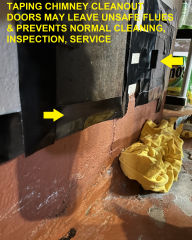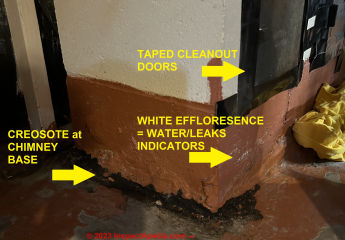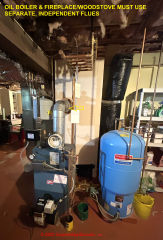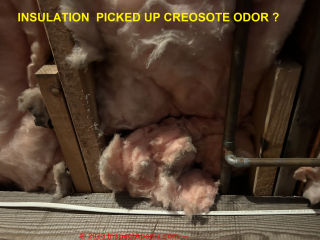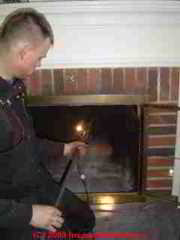 Chimney Creosote Odors & Smells
Chimney Creosote Odors & Smells
Cures & safety warnings
- POST a QUESTION or COMMENT about the causes and cures for creosote smells in buildings
Causes and cures for creosote smells in buildings - traced to chimney creosote deposits.
Odors emanating from creosote, whether from creosote wood treatment chemicals or from creosote deposited in a chimney by burning wood, are principally polycyclic aromatic hydrocarbons or PAHs that are described as smelling somewhat like asphalt or tires.
As discussed here in chimney creosote, these PAHs are formed when wood is burned in a woodstove or fireplace and are described as a product of incomplete (or imperfect) combustion. PAHs are potentially dangerous as carcinogens and mutagens, particularly for people or animals exposed to high or chronic levels of these substances. (AG 2021)
This article explains how seepage or leaks at chimneys combined with heavy creosote deposits can cause chimney odors and hazards in a building.
We provide solutions for removing the creosote and curing any remaining creosote odor.
InspectAPedia tolerates no conflicts of interest. We have no relationship with advertisers, products, or services discussed at this website.
- Daniel Friedman, Publisher/Editor/Author - See WHO ARE WE?
Creosote odors in buildings: causes & cures
 You may smell a chemical odor that is traced to a chimney, woodstove, or fireplace or the chimney that serves that when that system is not in use, typically in the spring and summer and during wet weather.
You may smell a chemical odor that is traced to a chimney, woodstove, or fireplace or the chimney that serves that when that system is not in use, typically in the spring and summer and during wet weather.
Creosote is a black, oily wood-tar condensate that forms in chimneys over fireplaces or woodstoves is a black tarry condensate that forms inside of chimneys and flues when burning wood in fireplaces and woodstoves.
Photo: extreme creosote leakage and possibly fire soot around a chimney-woodstove connection, now closed, pointed out by our inspection customer.
[Click to enlarge any image]
Creosote deposits accumulate in all types of chimneys - masonry, or metal, where wood burning appliances are vented.
Water entering the chimney from the top (leaks, or a bad or missing cap) or moisture condensation forming inside the flue can dissolve some of the creosote deposits leading to an odor that can be quite strong indoors.
A downdraft through the chimney also brings those odors into the home. Have the chimney inspected and cleaned and close the damper when the chimney is not in use.
Watch out: creosote will burn at a very high temperature - it is combustible. That's why creosote deposits risk a dangerous chimney fire.
Reader Question: how do I get rid of a chimney creosote odor indoors?
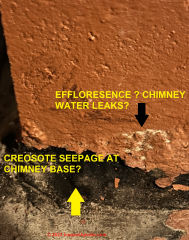 My husband had a wood stove for many years, which was removed about 7 years ago.
My husband had a wood stove for many years, which was removed about 7 years ago.
The house still has a persistent creosote smell, worse after it rains.
I have noticed creosote on the basement floor around the chimney base (the wood stove was on the first floor).
I have tried baking soda and white vinegar to deal with the smell and it formed a paste that congealed and had a creosote smell.
In doing so, I see that he essentially painting over a good amount of creosote almost mounded up against the base of the chimney.
He used a waterproof paint on the basement floor years ago and must have painted right over the creosote.
I believe I have uncovered a larger problem with my “paste” solution and knowing that creosote can be toxic, I wanted to reach out for advice.
Painting over it certainly did not seal the smell, but uncovering it as I did means we can hopefully deal with it safely and more effectively now.
Thank you for any advice you can offer,. - anonymous by private email 2023/07/07
Moderator reply: suggestions for finding and removing source of chimney creosote odors / smells
Thank you for a helpful creosote odor removal or cure question, one that involves more than just a creosote smell or creosote toxicity hazard, but also a risk of a chimney fire or house fire if that chimney is still in use.
Your baking soda and vinegar effort to remove creosote odors was described by the Chicago Brick Co. Other sources add the suggestion of using distilled white vinegar or ammonia to clean a creosote-smelly fireplace.
Really? Well maybe, for a modest creosote odor problem, but in my OPINION these measures are not effective when there is a large reservoir of creosote in a fireplace or chimney, and worse, just treating the odor risks failing to notice an important life-safety hazard that might be present - as we'll explain below.
So let's set some priorities of concern, putting safety first, then things to investigate, and then I'll include some remedial suggestions.
- Watch out: Chimney Safety warning:
If this chimney is still in use by any heating appliance and a creosote deposit remains in the flue, there is risk of a serious chimney fire that can even burn down the building. So my first priority, IF the chimney is in use, would be to order a complete chimney safety inspection by a certified chimney sweep or similar expert.
Those details are at CREOSOTE FIRE HAZARDS where we mention that the combination of creosote build-up + water or moisture can cause strong creosote odors in a building.
Your chimney inspector may use a chimney scanning camera to inspect the entire flue not just for creosote, but for damage such as cracks, leaks, missing cap or crown, or other faults that could be unsafe - and need correction.
Indoor creosote cleanup safety: when cleaning up or handling creosote waste from a fireplace or chimney, you should avoid prolonged skin or eye exposure, wear protective clothing, avoid prolonged vapor exposure, and wash your hands and clothes after touching any chemicals, including creosote. (TX CEQ 2002)
- Chimney defects risking damage or contributing to creosote odors:
Those same chimney defects, particularly leaks into the chimney from a missing rain cap or from other leak points, can also cause both further chimney damage and also can be a significant cause of creosote odors indoors, since water dissolving creosote causes that thinned substance to seep out of the chimney not just where you've already seen it, at the chimney base or cleanout door, but possibly elsewhere in the building.
You might look indoors, such as where a chimney passes through an attic, for leak stains that are both hazard indicators and a possible creosote odor source.
See details at CHIMNEY STAINS, INDOORS
- Clean the entire chimney flue:
If no chimney repairs are needed, and even if the chimney is to be abandoned entirely, you'll want the creosote deposits cleaned from the flue, both to avoid a future fire risk when someone else comes to use the building and to reduce the main source of the creosote odors that prompted your question.
Most likely the same person who inspected your chimney flue can clean it for you. That cleaning should include removing painted-over creosote deposits around the chimney base or cleanout door, but as I've suggested, those are probably just the tip of the creosote odor iceberg.
See details at CHIMNEY CLEANING PROCEDURES
You'll also want to be sure that the chimney cleanout door itself is sound and closes properly.
That's described at CHIMNEY CLEANOUT DOOR - Confirm no improper flue or chimney sharing:
More generally, your chimney inspector/cleaner should also confirm that the chimney or creosote-lined flue is not also in use by some other heating equipment and is not shared between fireplaces or woodstoves or heaters on different levels or floors in your building. - Fresh air ventilation:
Once you've removed the source (creosote) and causes (often leaks around the chimney) of creosote odors you may still need to ventilate the home with fresh air as soon as weather permits.
- Get rid of persistent creosote odors after cleanup:
If you find that creosote odors are persistent, as a few of our readers have suggested even after taking the steps we recommend above, then if you are confident that the creosote deposits themselves have been removed from your chimney (thin black coatings remaining on the chimney flue interior should not be a problem), then it's possible that creosote VOCs or odors have permeated building surfaces or furnishings.
In that case a combination of cleaning (carpets, drapes, rugs) and sealing of surfaces (painted walls or ceilings in the room where odors are worst) may be needed.
Building fire odor sealant paints, specially developed for that purpose, can help solve this creosote odor problem after the other creosote odor removal steps above have been taken.
See FIRE & SMOKE ODOR REMOVAL where we provide
7 METHODS for REMOVING FIRE & SMOKE ODORS
and we discuss use of sealants to stop odors from building surfaces that are otherwise undamaged.
Usually these coatings are either clear or white but may be pigmented to other colors. They are low VOC products that, after initial drying, do not emit odors.See those products discussed
at DISINFECTANTS, SANITIZERS, FUNGICIDAL-SEALANTS SOURCES
Watch out: Before doing anything troublesome or costly, including painting walls or ceilings, see our diagnostic steps recommended
at ODOR DIAGNOSIS SIX STEPS
and SMELL PATCH TEST to FIND ODOR SOURCE (illustrated below) - More on chimney creosote odors:
You're right that creosote itself or its off gas products an be hazardous, but normally cleaning a chimney to remove heavy creosote deposits and fixing any leaks, missing rain cap, or other chimney defects ought to be the end of the odor problem. A remaining black stain on the interior of a flue is not likely to be a significant creosote odor source.
The odors usually come from heavy creosote deposits, exacerbated by high interior moisture levels or by actual water leaks into the chimney and down the flue.
Those are discussed at CREOSOTE HAZARDS
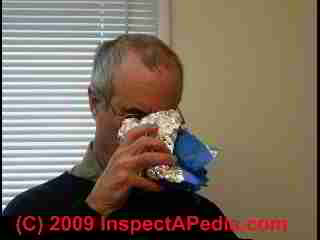
It would be helpful if you could show me a sharp photo of the deposits and conditions around the chimney base, and a second photo of the chimney top viewed from outdoors.
Watch out: creosote itself can affect your health: it is a skin, eye, and respiratory irritant. Depending on the level and location of exposure, creosote can also act as a carcinogen.[1][2]
Reader follow-up:
I’ve attached some photos of the creosote at the base of the chimney in the basement. You can see how bad it is.
I started by gorilla taping the doors shut to see if that stopped the smell.
Then I tried scrubbing with baking soda and white vinegar which peeled away some of the paint and showed the black mess underneath.
You can see from the pictures that he essentially painted over quite a mess.
The irony is that he doesn’t even smell it! But I do and I have mild asthma. I just don’t think he realized the problem.
Happy to have you share my question ...
I’m trying to gather as much info as I can before approaching my hubby about it. I asked him before about cleaning the chimney and he said it would be difficult because of the slate cap.
The builder of most houses in our plat (back in the 80s) was notorious for cutting corners, so I do wonder about the integrity of the chimney.
The hot water boiler is vented through the chimney, but we removed the wood stove on the first floor and closed in the chimney. The chimney has a cap.
It seems like there’s staining (oil? creosote?) on the insulation and some beams in the basement.
I’ll check out the attic for creosote stains on the chimney exterior and ceiling rafters as well.
Moderator reply:
The photos are helpful in guessing at the additional steps needed to get rid of this creosote smell around your chimney and perhaps elsewhere in the home.
Above: you report that the black seepage at the chimney base is creosote. In my opinion trying to seal up the chimney to stop an odor complaint is both unlikely to work and possibly unsafe.
It looks to me as if there might be some asphalt flashing sealant product that someone used to try to slow a leak but in any event the white stains and possibly soft painted-over deteriorated material a few inches up from the floor add evidence that water is running inside this chimney flue - a condition that not only risk damage to both the woodstove flue and the oil fired heater flue that could make either of these unsafe.
Water could be entering at the chimney top, along the chimney sides outdoors, at a rooftop flashing error, and even from surface runoff leaking into the chimney near ground level.
Taping the cleanout doors is worthwhile just as a test but it's not going to fix the creosote odor problem, it doesn't address the reservoir of creosote inside the chimney flue, and it interferes with normal and proper chimney inspection and cleaning.
Your photo of an oil fired boiler (above) combined with the width of the chimney as seen from outdoors (below) and the photo of what looks like two separate chimney base cleanout doors all suggest that the chimney may have been constructed with two separate flues, one for the woodstove or a fireplace and the other for the basement heating equipment - presently an oil fired boiler.
(It would be improper and unsafe for both boiler and woodstove to share a flue.)
Below: your photo of exposed fiberglass insulation suggests that the insulation might have absorbed some creosote smell - if so, our smell patch test or even a careful (don't breathe in fiberglass) sniff can perhaps answer that question. If the insulation is smelly, replace it.
Chimney flues can be cleaned from the rooftop but often they're first inspected and possibly also cleaned from inside the building using first a chimney scanning camera run up the flue from below.
The thorough inspections of the entire passage of both the in-use chimney flue (oil boiler) and the abandoned woodstove flue are both important for safety and as a diagnostic step in understanding where there may be leaks or other damage.
If your chimney service person can't or won't clean these flues, it's time to look further for someone who can.
If inspection in the attic shows leaks around the chimney flashing or out of the sides of the chimney itself, that's more data indicating that leak repairs are needed.
Ultimately the combination of cleaning the flue and stopping leaks into the flues should address both the odor complaint and the safety concerns that we've cited.
Research on Creosote Odor & Odor Removal
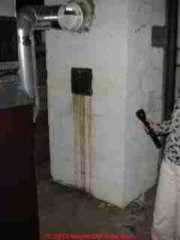 Note: most of the research on creosote hazards, avoidance, remedy, health risks, have focused on creosote treated wood - as a preservative. These documents still offer some help in dealing with creosote smells inside of a home and that originated in a wood-burning fireplace or chimney.
Note: most of the research on creosote hazards, avoidance, remedy, health risks, have focused on creosote treated wood - as a preservative. These documents still offer some help in dealing with creosote smells inside of a home and that originated in a wood-burning fireplace or chimney.
For removing the source and treating the after effects of indoor creosote odors due to a chimney or fireplace or woodstove, be sure to read the procedures and warnings given above on this page.
Photo: creosote bleed-out stains below a chimney clean-out door.
- AG, Afirm Group, POLYCYCLIC AROMATIC HYDROCARBONS (PAHs) [PDF) (2021) Afirm Group, retrieved 2023/07.08, original source: afirm-group.com/wp-content/uploads/2021/07/afirm_polycyclic_aromatic_hydrocarbons_v2.pdf
- ATSDR, PUBIC HEALTH STATEMENT for CREOSOTE [PDF] US EPA, ATSDR, retrieved 2023/07/08, original source: wwwn.cdc.gov/tsp/PHS/PHS.aspx?phsid=64&toxid=18
Excerpt:
Creosotes are created by high-temperature treatment of beech and other woods (beechwood creosote) or coal (coal tar creosote), or from the resin of the creosote bush (creosote bush resin). Wood creosote is a colorless to yellowish greasy liquid with a characteristic smoky odor and sharp burned taste. It is relatively soluble in water.
Creosote prepared from coal tar is the most common form of creosote in the workplace and at hazardous waste sites in the United States. Coal tar creosote is a thick, oily liquid that is typically amber to black in color. It is easily set on fire and does not dissolve easily in water.
Coal tar and coal tar pitch are the by-products of the high-temperature treatment of coal to make coke or natural gas.
They are usually thick, black or dark brown liquids or semisolids with a smoky or aromatic odor. Coal tar residues can also be found in the chimneys of homes heated with coal, especially if insufficient oxygen is present.
Chemicals in the coal tar pitch can be given off into the air as coal tar pitch volatiles when coal tar pitch is heated. - ATSDR, ToxFAQs™ for POLYCYCLIC AROMATIC HYDROCARBONS (PAHs) [PDF]
Agency for Toxic Substances and Disease Registry (ATSDR), US CDC, Atlanta, Georgia, USA Web: atsdr.cdc.gov/toxfaqs/index.asp. ATSDR can tell you where to find occupational and environmental health clinics. Their specific functions concern the effect on public health of hazardous substances in the environment.
Excerpt: Polycyclic aromatic hydrocarbons (PAHs) are a group of over 100 different chemicals that are formed during the incomplete burning of coal, oil and gas, garbage, or other organic substances like tobacco or charbroiled meat.
PAHs are usually found as a mixture containing two or more of these compounds, such as soot. Some PAHs are manufactured. These pure PAHs usually exist as colorless, white, or pale yellow-green solids.
PAHs are found in coal tar, crude oil, creosote, and roofing tar, but a few are used in medicines or to make dyes, plastics, and pesticides.
Excerpt: This fact sheet answers the most frequently asked health questions (FAQs) about polycyclic aromatic hydrocarbons (PAHs). For more information, call the CDC Information Center at 1-800-232-4636. - Bateman, Ernest. "THE RELATION BETWEEN THE TOXICITY AND THE VOLATILITY OF CREOSOTE OILS." Industrial & Engineering Chemistry 8, no. 12 (1916): 1094-1095.
- Byers, H. G., and Paul Hopkins. "AN INVESTIGATION OF WOOD TAR FROM THE DOUGLAS FIR,“PSEUDOTSUGA TAXIFOLIA.”." Journal of the American Chemical Society 24, no. 8 (1902): 764-771
- Chicago Brick Co, HOW TO GET RID of FIREPLACE SMELL & REMOVE the CREOSOTE SMELL (excerpts) [PDF] (2023) Chicago Brick Co., 819 N. Milwaukee Ave, Chicago, IL 60642, USA, Email: info@chicagobrickco.com Tel: 312-733-3300 Web: chicagobrickco.com
- Ehrlich, G. G., D. F. Goerlitz, E. M. Godsy, and MFp Hult. "Degradation of phenolic contaminants in ground water by anaerobic bacteria: St. Louis Park, Minnesota." Groundwater 20, no. 6 (1982): 703-710.
- George, Capt. "TO REMOVE ODORS [PDF] in Miscellany, 5 August ????
Excerpt: To Remove Odors.—The odor of iodoform, creosote or guaiacol may be removed from the hands by washing with linseed meal.
Tar water containing oil of wintergreen will remove the odor of iodoform from articles to which it attaches.
Powdered coffee will disguise the taste of creosote pills, while burning coffee dissipates the odor of guaiacol or iodoform in rooms. — Pharmaceutical Era. - Mikašauskaitė-Tiso, Jurgita, Nicola Tiso, Vilija Snieškienė, Antanina Stankevičienė, Mantas Stankevičius, Audrius-Sigitas Maruška, Tomas Drevinskas et al. "Investigation of bioremediation of creosote impregnated wooden railway sleepers." In The vital nature sign [elektroninis išteklius]: 7-th international scientific conference: abstract book. Kaunas: Vytautas Magnus university, 2013,[no. 7]. Kaunas: Vytautas Magnus University, 2013.
Abstract:
Railway sleepers impregnated with creosote or coal tar, contribute to the preservation of more than fifty years. Creosote, a distillation product of coal tar is one of the most widely used wood preservatives in the world. Used wooden sleepers are removed and stored in large quantities or being left in the environment.
The Directive on Waste (75/442/EEC), (91/156/EEC), which establishes the EU waste policy, prohibits the uncontrolled waste disposal and requires to dispose waste without danger, noise and odors.
The aim of this research is to determine the efficacy of selected basidiomycetes in the removing of polycyclic aromatic hydrocarbons (PAH) from the creosote-contaminated soil. Fungi Pleurotus ostreatus demonstrate positive interaction in creosote biodegradation.
Quantity of creosote in treated wood sleepers can be estimated by measuring PAH content, using analytical methods like GC-MS, GC-FID, HPLC. - National Chimney Sweeps Guild, NCSG, 2155 Commercial Drive, Plainfield, IN 46168, Tel: 317) 837-1500, Website: http://www.ncsg.org/ , Email: mmcsweeney@ncsg.org
- Princeton, WOOD-TREATING SITES & THEIR CLEANUP [PDF] Princeton University, retrieved 2023/0708 original source: princeton.edu/~ota/disk1/1995/9509/950904.PDF
Includes description of creosote cleanup strategies, products, chemicals, treatments at these sites. - Ed.
Excerpts: For sites contaminated with preservatives such as those used at the Texarkana Wood Preserving site, EPA suggests bioremediation as the preferred cleanup remedy.
If bioremediation is found to be infeasible, thermal desorption methods are to be considered. Incineration may be selected if bioremediation and thermal desorption are not feasible.
In downplaying the role of incineration among the presumptive remedies, EPA stresses the difficulty in gaining public support, but recognizes the method’s effectiveness.
... . This chapter provides a description of the contaminants typically found at wood-treating sites, a list of the remedies that have been selected at Superfund wood-treating sites, and a summary of EPA’s recent efforts to standardize the remedy selection process at wood-treating sites. - Szydlowski, M. "Odour nuisance of railway sleepers saturated with creosote oil." Chemical engineering transactions 54 (2016): 163-168.
- Texas CEQ, CREOSOTE, WHAT IS IT? WHAT ARE THE RISKS? [PDF] (2002) Texas Commission on Environmental Quality, retrieved 2023/07/08, original source: tceq.texas.gov/downloads/publications/gi/creosote-gi-285.pdf
- Vaught, Charles C. & Rebecca L. Nicholson, Evaluation of Emission Sources From Creosote Wood Treatment Operations [PDF] (1989) U.S. EPA, EPA-450/3-89-028, Midwest Research Institute Suite 360, 401 Harrison Oaks Blvd., Cary NC 27513, USA.
- Voorhies, Glenn. OIL TAR CREOSOTE FOR WOOD PRESERVATION [PDF] (1940). Thesis, Oregon State College.
...
...
Continue reading at FIRE & SMOKE ODOR REMOVAL or select a topic from the closely-related articles below, or see the complete ARTICLE INDEX.
Or see these
Recommended Articles
- CHIMNEY CLEANING PROCEDURES
- CHIMNEY FIRE ACTION / PREVENTION
- CREOSOTE FIRE HAZARDS
- CREOSOTE HAZARDS
- CREOSOTE ODOR CURE / REMOVAL
- FIRE CLEARANCES INDOORS
- FIRE DAMAGED BUILDINGS
- FIRE & SMOKE ODOR REMOVAL - home
- ODOR DIAGNOSIS SIX STEPS
- SMELL PATCH TEST to FIND ODOR SOURCE
- WOOD STOVE OPERATION & SAFETY
Suggested citation for this web page
CREOSOTE ODOR CURE / REMOVAL at InspectApedia.com - online encyclopedia of building & environmental inspection, testing, diagnosis, repair, & problem prevention advice.Or see this
INDEX to RELATED ARTICLES: ARTICLE INDEX to CHIMNEYS & FLUES
Or use the SEARCH BOX found below to Ask a Question or Search InspectApedia
Or see this
INDEX to RELATED ARTICLES: ARTICLE INDEX to BUILDING ENVIRONMENT
Or use the SEARCH BOX found below to Ask a Question or Search InspectApedia
Ask a Question or Search InspectApedia
Try the search box just below, or if you prefer, post a question or comment in the Comments box below and we will respond promptly.
Search the InspectApedia website
Note: appearance of your Comment below may be delayed: if your comment contains an image, photograph, web link, or text that looks to the software as if it might be a web link, your posting will appear after it has been approved by a moderator. Apologies for the delay.
Only one image can be added per comment but you can post as many comments, and therefore images, as you like.
You will not receive a notification when a response to your question has been posted.
Please bookmark this page to make it easy for you to check back for our response.
IF above you see "Comment Form is loading comments..." then COMMENT BOX - countable.ca / bawkbox.com IS NOT WORKING.
In any case you are welcome to send an email directly to us at InspectApedia.com at editor@inspectApedia.com
We'll reply to you directly. Please help us help you by noting, in your email, the URL of the InspectApedia page where you wanted to comment.
Citations & References
In addition to any citations in the article above, a full list is available on request.
- [8] National Fireplace Institute - NFI, Website: http://nficertified.org/ Quoting from the associations website:
The National Fireplace Institute® is the professional certification division of the Hearth, Patio & Barbecue Education Foundation (HPBEF), a 501(c)3 non-profit educational organization for the hearth industry. - [9] International Association of Fireplace and Chimney Inspectors, Inc., IAFCI, 5325 N Commerce Ave Ste 5 Moorpark, CA 93021, Website: http://
- In addition to citations & references found in this article, see the research citations given at the end of the related articles found at our suggested
CONTINUE READING or RECOMMENDED ARTICLES.
- Carson, Dunlop & Associates Ltd., 120 Carlton Street Suite 407, Toronto ON M5A 4K2. Tel: (416) 964-9415 1-800-268-7070 Email: info@carsondunlop.com. Alan Carson is a past president of ASHI, the American Society of Home Inspectors.
Thanks to Alan Carson and Bob Dunlop, for permission for InspectAPedia to use text excerpts from The HOME REFERENCE BOOK - the Encyclopedia of Homes and to use illustrations from The ILLUSTRATED HOME .
Carson Dunlop Associates provides extensive home inspection education and report writing material. In gratitude we provide links to tsome Carson Dunlop Associates products and services.



